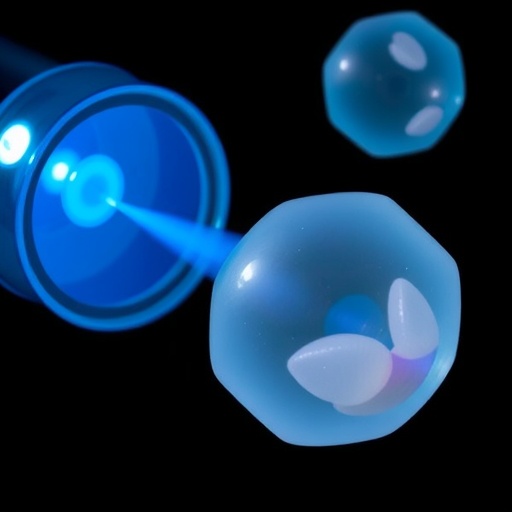In a groundbreaking advance set to redefine the landscape of biomedical engineering and material science, researchers from McGill University, in close collaboration with Polytechnique Montréal, have unveiled an innovative method to fabricate hydrogels using ultrasound technology. This pioneering technique eliminates the dependence on toxic chemical initiators—substances traditionally required to trigger polymerization—heralding a safer, more efficient, and environmentally sustainable approach to hydrogel production. The implications of this work extend across multiple domains, promising to accelerate progress in tissue engineering, regenerative medicine, bioadhesives, and 3D bioprinting with unprecedented precision and speed.
Hydrogels represent a unique class of polymeric materials distinguished by their remarkable ability to absorb and retain large quantities of water while maintaining structural integrity. Their biocompatibility, flexibility, and hydrophilic nature have facilitated wide-ranging applications, from soft contact lenses and wound dressings to drug delivery systems and soft robotics. Despite their versatility, the traditional methodologies to produce hydrogels have been hampered by prolonged fabrication times and reliance on chemical initiators, some of which pose toxicity risks that undermine their clinical applicability and environmental safety.
The innovative method devised by the McGill-led team replaces these chemical initiators with high-frequency ultrasound waves, leveraging a phenomenon known as acoustic cavitation. When ultrasound propagates through the liquid precursor containing the hydrogel monomers, it induces the formation of microscopic gas bubbles. These bubbles undergo rapid expansion and violent collapse, releasing tremendous localized energy. This energy suffices to initiate the polymerization reactions necessary to form the hydrogel network, effectively bypassing the need for extrinsic chemical agents that generate potentially harmful side-products.
Professor Jianyu Li, leading the Mechanical Engineering group at McGill University, emphasizes the transformative potential of this approach: “Our principal motivation was to address the health and environmental hazards posed by conventional chemical initiators. Using ultrasound as a clean energy source, we can catalyze gelation reactions rapidly and without toxic by-products, thus enhancing both safety and sustainability.” Remarkably, this method accelerates hydrogel formation drastically, reducing the synthesis timeline from hours—or overnight polymerization under ultraviolet light—to a matter of mere minutes.
Beyond tissue engineering, the sonogel method introduces a paradigm shift in the realm of 3D bioprinting. Traditional bioprinting often relies on photopolymerization triggered by ultraviolet or visible light, which poses depth penetration limitations and potential cell damage. By harnessing high-intensity focused ultrasound (HIFU), researchers can sculpt and solidify hydrogel structures layer by layer with superior depth penetration and spatial precision. Jean Provost, assistant professor of engineering physics at Polytechnique Montréal and co-author of the research, highlights: “Ultrasound enables unparalleled three-dimensional control, facilitating the fabrication of complex, cell-laden architectures previously unattainable with light-based methods.”
Mechanistically, the sonogel formation is contingent upon the regulation of ultrasound parameters—frequency, intensity, and pulse duration—which govern the cavitation dynamics and thus the polymerization kinetics. Precise tuning enables modulation of network density and crosslinking, directly influencing the mechanical and swelling characteristics of the resulting hydrogels. This level of control is vital for tailoring hydrogels for specific biomedical functions, including load-bearing scaffolds in cartilage repair or flexible matrices for neural regeneration.
Environmental sustainability is another profound advantage of this ultrasound-based synthesis. By eschewing chemical initiators, the process significantly diminishes the generation of hazardous waste and reduces reliance on specialized reagents derived from petrochemical sources. This aligns with the broader global objective towards greener manufacturing processes in biomaterials and pharmaceuticals. The rapid, energy-efficient gelation further decreases the overall carbon footprint of hydrogel production.
Published in the journal Advanced Science, the study titled “Ultrasound Cavitation Enables Rapid, Initiator-Free Fabrication of Tough Anti-Freezing Hydrogels” presents detailed experimental validations of the sonogel technique. The research team conducted extensive mechanical testing, thermal characterization, and biocompatibility assessments, confirming the superior properties and safety profile of the resulting hydrogels. This work was supported by the NSERC/FRQNT NOVA program, underscoring the significance attributed to innovative green technologies in Canadian scientific funding.
Looking ahead, researchers are optimistic about expanding the versatility of sonogel technology. Ongoing studies aim to explore its compatibility with diverse monomer chemistries, integration with stimuli-responsive elements, and scalability for industrial manufacturing. There is particular excitement around utilizing sonogels as platforms for controlled drug release, bioadhesion in surgical applications, and fabrication of dynamic soft robotic components.
The fusion of ultrasound physics, polymer chemistry, and bioengineering exemplified in this work reflects an interdisciplinary breakthrough that not only enhances material performance but also paves the way for next-generation biomedical devices and therapies. As the scientific community increasingly prioritizes safety, sustainability, and efficacy, the sonogel approach stands out as a revolutionary stride towards meeting these demands in hydrogel science.
Subject of Research: Hydrogel fabrication using ultrasound-induced polymerization without chemical initiators
Article Title: Ultrasound Cavitation Enables Rapid, Initiator-Free Fabrication of Tough Anti-Freezing Hydrogels
Web References: https://advanced.onlinelibrary.wiley.com/doi/10.1002/advs.202416844
References: Yixun Cheng, Jianyu Li, et al., Advanced Science
Keywords
Hydrogels, Ultrasound, Polymer chemistry, Tissue engineering, Sonogel, 3D bioprinting, Acoustic cavitation, Biomedical materials, Initiator-free polymerization, Regenerative medicine
Tags: 3D bioprinting innovationsacoustic cavitation in material scienceapplications of hydrogels in tissue engineeringbioadhesives developmentbiomedical engineering advancementschallenges in traditional hydrogel manufacturingeco-friendly hydrogel fabrication methodsenvironmental sustainability in biomedical materialshydrophilic polymer propertiesnon-toxic polymerization techniquesregenerative medicine breakthroughsultrasound technology in hydrogel production






